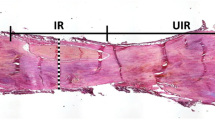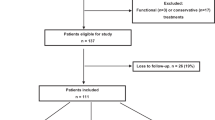Abstract
Purpose
To compare the biomechanical and histological properties of Achilles tendons repaired at different time points during the acute injury period.
Methods
Thirty-six skeletally mature Sprague–Dawley rats underwent bilateral mid-substance Achilles tenotomy. The Achilles tendons were repaired either in the first 24 h (group 1), 24–48 h (group 2), 48–72 h (group 3), or > 72 h (mean: 120 ± 5.2 h) (group 4) after tenotomy. Six weeks after repair, nine tendons per group were assessed biomechanically and histologically. The Stoll histological scoring system was used for histological examination. The groups were compared with each other and native tendons (control group). The correlations between biomechanical and histological results were analysed.
Results
There were no significant differences between groups 1, 2 and 3 regarding the mean load to failure; it was significantly lower in group 4. Healed tendons in groups 1, 2 and 3 had significantly greater stiffness than native tendons and group 4 tendons. All healed tendons had a larger cross-sectional area than native tendons. There was no significant difference in tendon length between the groups. There was no significant difference in Young’s modulus between the groups; Young’s modulus was lower in all the groups than in the control group. Group 1 had significantly higher extracellular matrix organization, cell alignment, cell distribution and nucleus morphology scores and total scores than group 4. Group 1 had significantly higher extracellular matrix organization, cell distribution, vascularization and inflammation scores and total scores than group 3. A significant positive correlation was detected between the maximum load to failure and total histological score.
Conclusion
Repair of acute Achilles tendon rupture within 48 h, and especially in the first 24 h, provides better biomechanical and histological outcomes. In the clinical practice, the data could be used to decrease re-rupture rates, to achieve more anatomical tendon healing and to implement more effective post-operative rehabilitation programme.








Similar content being viewed by others
References
Anathallee MY, Liu B, Budgen A, Stanley J (2018) Is Achillon repair safe and reliable in delayed presentation Achilles tendon rupture? A 5-year follow-up. Foot Ankle Surg 24(4):296–299
Backer HC, Wong TT, Vosseller JT (2019) MRI assessment of degeneration of the tendon in Achilles tendon ruptures. Foot Ankle Int. https://doi.org/10.1177/1071100719845016
Carmont MR, Zellers JA, Brorsson A, Silbernagel KG, Karlsson J, Nilsson-Helander K (2018) No difference in strength and clinical outcome between early and late repair after Achilles tendon rupture. Knee Surg Sports Traumatol Arthrosc 1:1. https://doi.org/10.1007/s00167-018-5340-5
Chen TM, Rozen WM, Pan WR, Ashton MW, Richardson MD, Taylor GI (2009) The arterial anatomy of the Achilles tendon: anatomical study and clinical implications. Clin Anat 22(3):377–385
Dogan A, Korkmaz M, Cengiz N, Kalender AM, Gokalp MA (2009) Biomechanical comparison of Achilles tenotomy and achilloplasty techniques in young rats: an experimental study. J Am Pod Med Assoc 99(3):216–222
Dyment NA, Hagiwara Y, Matthews BG, Li Y, Kalajzic I, Rowe DW (2014) Lineage tracing of resident tendon progenitor cells during growth and natural healing. PLoS One 9(4):e96113
Egger AC, Berkowitz MJ (2017) Achilles tendon injuries. Curr Rev Musculoskelet Med 10(1):72–80
Eliasson P, Agergaard AS, Couppé C et al (2018) The ruptured Achilles tendon elongates for 6 months after surgical repair regardless of early or late weightbearing in combination with ankle mobilization: a randomized clinical trial. Am J Sports Med 46(10):2492–2502
Ganestam A, Kallemose T, Troelsen A, Barfod KW (2016) Increasing incidence of acute Achilles tendon rupture and a noticeable decline in surgical treatment from 1994 to 2013. A nationwide registry study of 33,160 patients. Knee Surg Sport Traumatol Arthrosc 24(12):3730–3737
Grassi A, Amendola A, Samuelsson K, Svantesson E, Romagnoli M, Bondi A, Mosca M, Zaffagnini S (2018) Minimally invasive versus open repair for acute Achilles tendon rupture: meta-analysis showing reduced complications, with similar outcomes, after minimally invasive surgery. J Bone Joint Surg Am 100(22):1969–1981
Guzzoni V, Selistre-de-Araújo HS, Marqueti RC (2018) Tendon remodeling in response to resistance training. Anabolic androgenic steroids and aging. Cells 7(12):E251
Kadakia AR, Dekker RG, Ho BS (2017) Acute Achilles tendon ruptures: an update on treatment. J Am Acad Orthop Surg 25(1):23–31
Kauwe M (2017) Acute Achilles tendon rupture: clinical evaluation, conservative management, and early active rehabilitation. Clin Podiatr Med Surg 34(2):229–243
Kjaer M, Langberg H, Miller BF et al (2005) Metabolic activity and collagen turnover in human tendon in response to physical activity. J Musculoskelet Neuronal Interact 5(1):41–52
Krapf D, Kaipel M, Majewski M (2012) Structural and biomechanical characteristics after early mobilization in an Achilles tendon rupture model: operative versus nonoperative treatment. Orthopedics 35(9):e1383–e1388
Labib SA, Hoffler CE, Shah JN, Rolf RH, Tingan A (2016) The gift box open aAchilles tendon repair method: a retrospective clinical series. J Foot Ankle Surg 55(1):39–44
Lemme NJ, Li NY, DeFroda SF, Kleiner J, Owens BD (2018) Epidemiology of aAchilles tendon ruptures in the United States: athletic and nonathletic injuries from 2012 to 2016. Orthop J Sports Med 6(11):2325967118808238
Maffulli N, Longo UG, Ronga M, Khanna A, Denaro V (2010) Favorable outcome of percutaneous repair of Achilles tendon ruptures in the elderly. Clin Orthop Relat Res 468(4):1039–1046
Müller SA, Evans CH, Heisterbach PE, Majewski M (2018) The role of the paratenon in Achilles tendon healing: a study in rats. Am J Sport Med 46(5):1214–1219
Ochen Y, Beks RB, van Heijl M, Hietbrink F, Leenen LPH, van der Velde D, Heng M, van der Meijden O, Groenwold RHH, Houwert RM (2019) Operative treatment versus nonoperative treatment of Achilles tendon ruptures: systematic review and meta-analysis. BMJ 364:k5120
Park YH, Jeong SM, Choi GW, Kim HJ (2017) How early must an acute Achilles tendon rupture be repaired? Injury 48(3):776–780
Pedowitz D, Kirwan G (2013) Achilles tendon ruptures. Curr Rev Musculoskelet Med 6(4):285–293
Rosenbaum AJ, Wicker JF, Dines JS et al (2010) Histologic stages of healing correlate with restoration of tensile strength in a model of experimental tendon repair. HSS J 6(2):164–170
Saper D, Lybrand K, Creevy W, Li X (2016) Using a posterior compartment fasciotomy and paratenon closure in acute Achilles tendon repair. Orthopedics 39(4):e790–e793
Schipper O, Cohen B (2017) The acute injury of the Achilles: surgical options (open treatment, and minimally invasive surgery). Foot Ankle Clin 22(4):689–714
Sebastin SJ, Ho A, Karjalainen T, Chung KC (2013) History and evolution of the Kessler repair. J Hand Surg Am 38(3):552–561
Sheth U, Wasserstein D, Jenkinson R, Moineddin R, Kreder H, Jaglal SB (2017) The epidemiology and trends in management of acute Achilles tendon ruptures in Ontario, Canada: a population-based study of 27,607 patients. Bone Joint J 99-B(1):78–86
Stoll C, John T, Conrad C et al (2011) Healing parameters in a rabbit partial tendon defect following tenocyte/biomaterial implantation. Biomaterials 32(21):4806–4815
Svedman S, Juthberg R, Edman G, Ackermann PW (2018) Reduced time to surgery improves patient-reported outcome after Achilles tendon rupture. Am J Sports Med 46(12):2929–2934
Woo SLY, Hildebrand K, Watanabe N, Fenwick JA, Papageorgiou CD, Wang JHC (1999) Tissue engineering of ligament and tendon healing. Clin Orthop Relat Res 367(Suppl):312–323
Wu F, Nerlich M, Docheva D (2017) Tendon injuries. Basic science and new repair proposals. EFORT Open Rev 2(7):332–342
Wu Y, Lin L, Li H et al (2016) Is surgical intervention more effective than non-surgical treatment for acute Achilles tendon rupture? A systematic review of overlapping meta-analyses. Int J Surg 36(Pt A):305–311
Funding
None.
Author information
Authors and Affiliations
Corresponding author
Ethics declarations
Conflict of interest
On behalf of all authors, the corresponding author states that there is no conflict of interest.
Ethical approval
All procedures performed in studies involving human participants were in accordance with the ethical standards of the institutional and/or national research committee and with the 1964 Helsinki declaration and its later amendments or comparable ethical standards.
Additional information
Publisher's Note
Springer Nature remains neutral with regard to jurisdictional claims in published maps and institutional affiliations.
Rights and permissions
About this article
Cite this article
Misir, A., Kizkapan, T.B., Arikan, Y. et al. Repair within the first 48 h in the treatment of acute Achilles tendon ruptures achieves the best biomechanical and histological outcomes. Knee Surg Sports Traumatol Arthrosc 28, 2788–2797 (2020). https://doi.org/10.1007/s00167-019-05536-w
Received:
Accepted:
Published:
Issue Date:
DOI: https://doi.org/10.1007/s00167-019-05536-w




